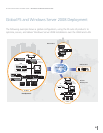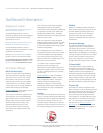
3
F5 APPLICATION READY NETWORK GUIDE: MICROSOFT WINDOWS SERVER 2008
Benefi ts and F5 Value
User Experience and
Application Performance
Microsoft Windows Server 2008 gives
organizations a powerful new platform that
is designed to power the next-generation of
networks, applications, and Web services.
Windows Server 2008 includes some exciting
new components such as Microsoft’s new
TCP/IP stack, Secure Socket Tunneling Protocol
(SSTP), and new versions of industry standard
applications like Windows Terminal Services
and Internet Information Services. F5 has been
working closely with Microsoft to ensure that
F5’s Application Ready Network for Microsoft
Windows Server 2008 provides the highest level
of application availability, performance, and end
user satisfaction.
One of the highlights of Microsoft Windows
Server 2008 is a next generation TCP/IP stack
that has been completely redesigned from
the ground up. F5 solutions include a host
of TCP/IP optimization technologies that are
compatible with Microsoft’s new stack. These
optimizations, which combine session-level
application awareness, persistent tunnels,
selective acknowledgements, error correction,
and optimized TCP windows, enable F5 devices
and Microsoft Server 2008 installations to fully
utilize available bandwidth. This enables F5
devices to adapt, in real time, to the latency,
packet loss, and congestion characteristics
of WAN links, and accelerate virtually all
application traffi c. And F5 isolates, controls,
and independently optimizes user and server
connections, enabling both the server and end
user to maximize productivity.
With the rapid expansion of the Internet
and the quickly diminishing number of IPv4
addresses available, organizations are looking
to ensure their network infrastructure is
adequately prepared for the future. Internet
Protocol version 6 (IPv6) support is no longer
a luxury, it is a necessity. IPv6, a new suite
of standard protocols for the network layer
of the Internet, is built into both Windows
Server 2008, as well as F5 devices, ensuring
that your network and Microsoft applications
are ready for this inevitable change. With
F5’s IPv6 support, organizations have a clear
strategy for staging network migration as IPv6
traffi c grows, without wholesale network and
application upgrades. Additionally, F5 devices
can perform IPv6/IPv4 translation, translating
traffi c for consumption by either IPv4 or IPv6
end points. This allows organizations to stage
their migration gradually as demand for IPv6
increases. F5 enables you to freely intermingle
IPv4 and IPv6 services on Windows Server
2008; for example, F5 can serve as an IPv4
front end to Windows Server 2008 Web
Access servers that only use IPv6. With F5,
organizations have a strong solution for today
and well into the future.
Windows Server 2008 is extremely effective
at what it was designed to do: provide a solid
foundation for server workload and application
requirements. One of F5’s core strengths is the
ability to enhance end-user experience while
increasing application and server performance.
We do this by taking on many of the duties
that servers traditionally have to perform. If
each server has to carry out processor-intensive
tasks such as compression, caching, and SSL
processing and certifi cate management, the
amount of processing power these devices
have left to perform core tasks is reduced.
By offl oading these types of tasks onto F5’s
centralized and high powered network devices,
F5 greatly improves Windows Server 2008
server effi ciency and enables organizations to
reduce the amount of hardware. This applies to
all the major components of Windows Server
2008, including Windows Terminal Services,
Internet Information Servers, and SSTP.
F5 provides technology that guarantees the
most effi cient network possible. Because
F5’s unique TMOS™ operating system is a
full proxy, it can optimize any end point that
connects through the system. As a full broker
of communications, the system optimizes
communication for every single end-device
communicating through it. This optimization
can take place up and down the entire stack
— from the transport layer to the protocol
and application layer — functions outside the
control of Windows Server 2008. This takes
the workload off of the Windows Server 2008
devices for increased server effi ciency. By
reducing unnecessary protocol communication
across the network, F5 improves application
response times and utilization for Windows
Server 2008 deployments and other
applications on the network.
Even high-powered and effi cient applications
and servers, like Windows Server 2008, as well
as other devices on the local area network
(LAN), are not much help over the wide area
network (WAN). Network latency across the
WAN is one of the biggest challenges facing
IT departments around the world, and is a
major concern for organizations deploying
applications like Windows Terminal Services
where users can access applications from
anywhere. Simply increasing bandwidth
does nothing to solve the problem. F5 helps
drastically reduce the impact of latency in a
number of ways. In addition to the benefi ts
from TMOS, F5 solves latency problems with a
group of capabilities that eliminates the need
for the browser to download repetitive or
duplicate data, as well as ensuring the best use
of bandwidth by controlling browser behavior.
By reducing the extra conditional requests
and excess data (re)transmitted between the
“Windows Server is one of
the most popular application
platforms that we see within
our enterprise customer
base. As such, F5 has put
substantial resources into
testing its application delivery
portfolio with the Windows
Server platform technologies
through every step of the
beta to maintain a high level
of interoperability.”
Jim Ritchings, VP of Business
Development at F5









